
Photo: BaralRohan | Wikimedia Commons
The city of Pokhara lives and breathes in the empty spaces amidst and between some gorgeous lakes and glimpses of the paradisiacal mountains. The name of this city is cognate of the Nepali word for ponds, i.e., “Pokhari.” And it is said that the waters of mountains like Annapurna bleeded into this valley and are sources of much of its still, glorious waters.
Drive around or stroll to some hilly vantage points and the majesty of the beautiful peaks, such as the first eight-thousander peak to be successfully climbed (i.eAnnapurna) and the highest mountain to has never been climbed (Machhapuchhre), that surround it are in plain sight.
The “father of trekking in Nepal,” Jimmy Roberts, described Pokhara as “his private Mecca.” Talking specifically about a mountain resembling the tail of a fish, i.e., the Matterhorn of Nepal(Machhapuchhre), which anyone in Pokhara can see, Robert’s said:
“There was Machapuchare shining in the moonlight, a great white pyramid incredibly aloof…So Machapuchare became for me the ideal of a mountain, a personal possession yet out of this world, unattainable but mine by illogical right, brooding over a country and a people who would shape the rest of my life.“
This city, this magical Pokhara, has shaped the lives of various people who have lived here, who have traveled here like Roberts, partied here, taking it all in to create the humdrum of its nightlife, the beautiful stretches of delectable cafes and ease with which anyone can reach here, a city that is a lovable, breathable- a must-go-to place.

Photo: Prasan Shrestha | Wikimedia Commons
Climate
The fact that Pokhara is a valley and lies in close proximity to the Himalayas makes its climate distinct, and so does the fact that Pokhara is the place that receives the highest amount of rainfall in the country.
Pokhara’s warm and temperate temperature has allowed the city to support a broad range of animals and birds, including many different monkey species, deer, and other bird species, including eagles, vultures, and peacocks.
Pokhara’s seasonal averages for temperature and precipitation are as follows:
Spring: From March through May, Pokhara has temperatures between 59 and 86 degrees Fahrenheit (15 to 30 degrees Celsius). Over 300mm of rain falls on average each spring in Pokhara.
Summer (June–August): With temperatures ranging from 20°C to 35°C (68°F to 95°F), Pokhara experiences a hot and muggy summer. Rainfall stretches up to 1000 mm this season.
Autumn (September to November): With beautiful skies and pleasant temperatures, autumn is the finest season to explore Pokhara. During this season, the temperature in Pokhara ranges from 10°C to 30°C (50°F to 86°F), and the average rainfall is roughly 100mm.
Winter (December–February): With temperatures ranging from 5°C to 20°C (41°F to 68°F), Winter is the coldest season in Pokhara. About 20mm of rain falls on average each Winter.
Pokhara’s weather patterns and climate have not changed oddly during the past few years. Extreme weather occurrences have been observed, including landslides and torrential rain, debilitatingly affecting local ecosystems.
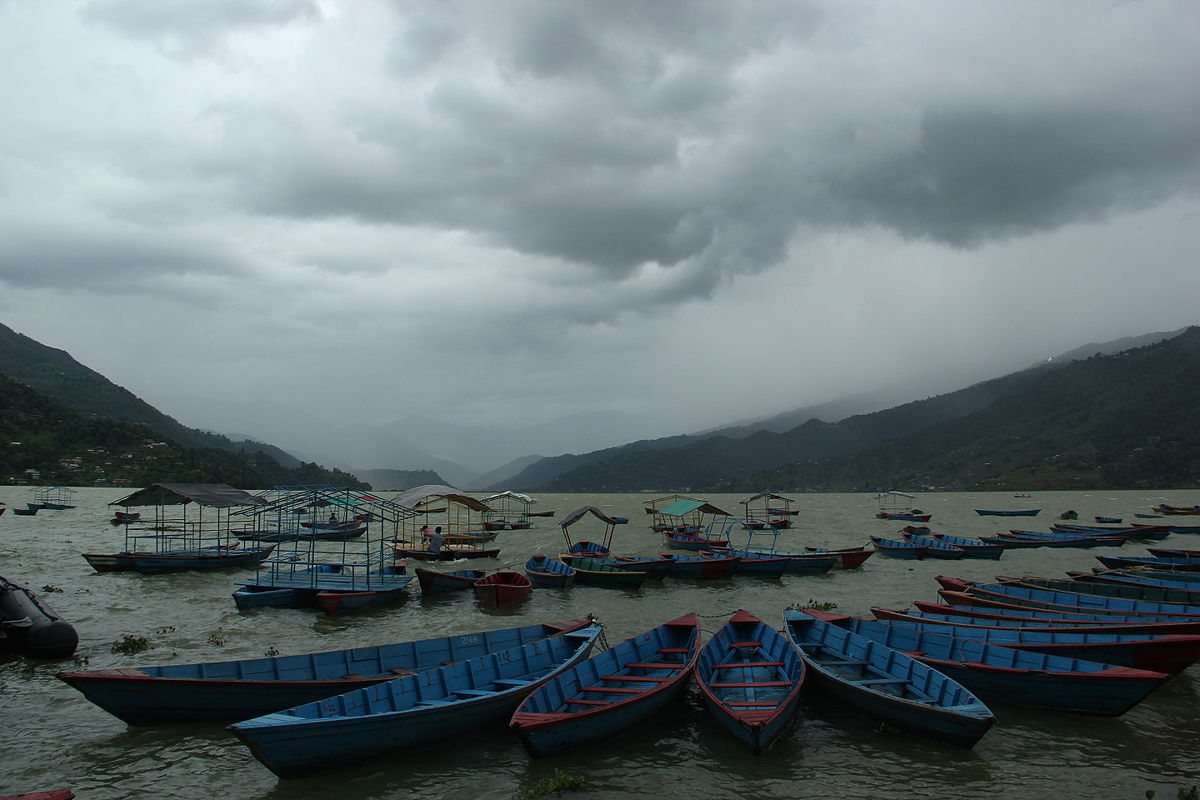
Photo: Nikesh balami | Wikimedia Commons
This has also led to variations in the temperature-related flowering and fruiting cycles of plants and trees. The city has implemented eco-friendly programs and promoted sustainable tourism practices to lessen the effects of climate change.
The city continues to be a favorite travel destination for travelers looking to explore the area’s natural beauty and diverse biodiversity, despite recent shifts in weather patterns.
Some lesser-known facts about Pokhara that add to its charm
- Pokhara was developed by the ancestor of the uniter of modern Nepal (Prithivi Narayan Shah).
- Legend has it that the Hindu Goddess Seti once passed through this region and felt thirsty. She tapped the ground with her staff, releasing a river, and her spirit still remains there.
- Despite its modern, bustling zeitgeist, the place was accessible only on foot until the 1960s.
- During China’s annexation of Tibet (1959-1962), hundreds of thousands of Tibetans entered Nepal– a good portion of whom touched Pokhara inspiring its Tibetan stupas.
- The myths of Yeti- the “Abominable Snowman” still lives in the mountains that surround Pokhara.
- Pokhara has always been home to the glorified military men of Nepal, “Gurkhas,” and houses a Gurkha Memorial Museum.
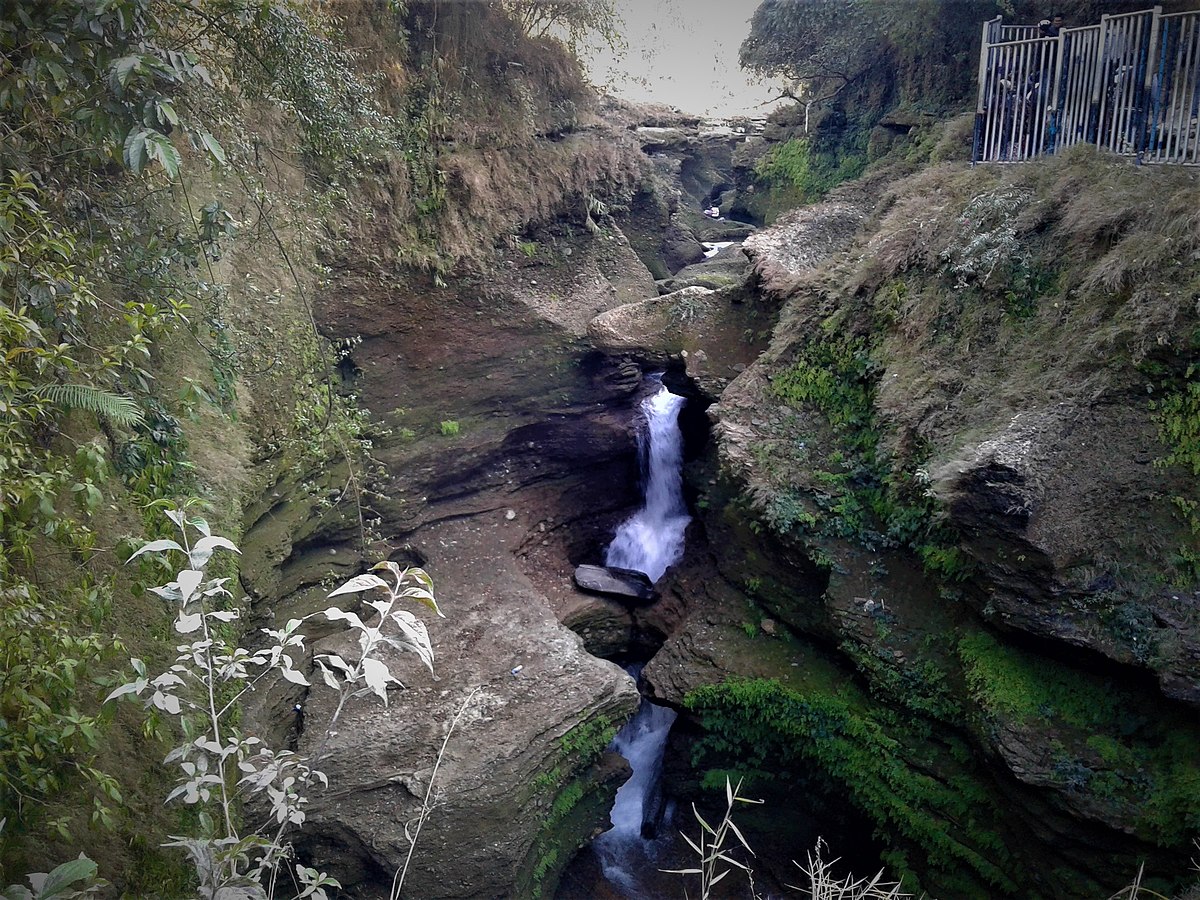
Photo: Sabina Bajracharya | Wikimedia Commons
Getting to Pokhara
By Foot
There is an ancient trekking trail starting from Kathmandu and culminating in Pokhara. Though only a few people dare this as they find taking a flight or a tourist bus to Pokhara easier, the lure of trekking to Pokhara is always there amongst people driving to be off-beat.
Starting at Budhanilkantha and traversing through Shivapuri National Park, the trail takes you along Kakani, Arughat, and Gorkha. Most of the trail is still doable though some sections have deteriorated and become small roads. If you’re looking for a mild trek, this is the one.
Pros
- The most environment-friendly way of getting to Pokhara
- Enjoy a trek that is unheard of in many places, not to say un-thought of
- A feel of how traveling was between two cities a few generations ago
Cons
- It takes a few days of your travel/ vacation time, which might not be ideal for those on a short holiday.
- The cost of accommodation and food along the way might be more expensive than taking a bus.
- Lodges/ tea houses along the way might not be available for booking online.
By Bus
Vacationers/ trekkers/tourists who are looking for a budget-friendly way to reach Pokhara opt to travel by bus. Numerous bus companies operate daily buses between Kathmandu and Pokhara. And depending upon the type of bus, i.e., tourist bus, A/C, local bus, microbus, etc., the cost can vary. Those who want a more private and pleasant mode of transportation can also access private cabs and rental cars from Nepal’s major cities.
The bus journey to Pokhara takes about 7-8 hours. Moreover, direct buses are available from important Nepali cities like Chitwan and Lumbini.
It is advised that travelers make their transportation arrangements in advance, especially during the busiest travel times. Due to the potential of heavy traffic, which can increase travel times and cause delays, avoiding rush hours is also advised.

Photo: calflier001 | Wikimedia Commons
Pros
- A ride along the scenic hills and rivers that surround Kathmandu and Pokhara
- Cheaper compared to airfare or trekking to Pokhara.
- More eco-friendly than Air travel in Nepal which is far from becoming Carbon-neutral.
Cons
- A bus ride eats away at night or a day (depending on when you travel), so it might not be suitable for people on the smallest of vacations.
- You will miss the aerial views of the hills and mountains.
- Possibility of traffic congestion as you leave Kathmandu or along the way (owing to some construction work or accidents)
By Air
The quickest and most time-efficient method of transportation between Kathmandu and Pokhara is via plane. Many airlines, including Nepal Airlines, Yeti Airlines, Buddha Air, and Shree Airlines, run daily flights between Kathmandu and Pokhara.
Depending on the airline and weather, flying from Kathmandu to Pokhara takes 25 to 30 minutes. The flights leave from Tribhuvan International Airport’s domestic terminal in Kathmandu and land at Pokhara International Airport. The domestic airport is there, but only short take-off and landing (STOL) aircraft operate to Jomsom from here.

Photo: Gaurav Dhwaj Khadka | Wikimedia Commons
You can use a travel agent or the airline’s website to reserve a flight from Kathmandu to Pokhara. It is advised to make your flight reservations in advance, especially during the busiest travel times when seats can sell out quickly.
Pros
- Staggering vistas of mountains and hills of the Annapurna range
- Fastest mode of transport to Pokhara
Cons
- Modern aviation has quite an impact on the environment.
- Problems with bird-strike (to aircraft) persist around Pokhara International Airport.
- More expensive than a bus-ride
Accommodation in Pokhara
In Pokhara, lodging options range from inexpensive guesthouses to opulent five-star hotels. The following list of hotel categories is organized according to their costs, services they provide, views they have nearby, and proximity to major markets:
Guesthouses on a Budget
Travelers seeking a comfortable stay at a reasonable cost consider budget guesthouses in Pokhara. These inns provide simple comforts like a tidy bed, a hot shower, and free WiFi. Some are close to popular tourist destinations and commercial hubs, making accessing eateries, stores, and activities simple. Some hotels might not have the nicest views or extra services, though.

Photo: calflier001 | Wikimedia Commons
Mid-Range Hotels
For a little bit more money, mid-range hotels in Pokhara provide more amenities than cheap guesthouses. These hotels offer cozy accommodations, a wide selection of dining options, swimming pools, and other leisure activities. Some give stunning views of the lake and the mountains because they are close to the lake. Yet, some hotels could be removed from the main shopping centers and tourist attractions.
Luxury Hotels and Resorts
The best amenities, including large rooms, fine dining choices, spa services, swimming pools, and other recreational activities, are available at luxury hotels and resorts in Pokhara. These hotels are in ideal locations with stunning views of the mountains and lake. They are expensive, though, and access to the major markets might be more complex.
Places to visit in Pokhara and a few interesting notes about them
- Phewa Lake: A local folklore amongst many holds that the massive, rising Mahabharat ridge choked up the Seti River, flooding the settlement and causing Lake Phewa to submerge the entire village. A beggar had just come to warn the people of an approaching flood. However, they had mistaken him for none other than the Goddess Barahi Bhagwati. Eventually, a shrine was built in the center of the lake by the descendants of those of the villagers who managed to escape and find refuge. This is the Tal Barahi- the island of a temple in Fewa Lake.
- World Peace Pagoda: It is one of the Two Peace Pagodas (out of a total of 80 throughout the world) in Nepal. The inspiration for this 115 feet tall and 344 feet wide monument comes from a Buddhist monk named Nichidatsu Fujii, who founded the Japan Buddha Sangha. After meeting Mahatma Gandhi, he was inspired to build a series of these stupas.

- Davis Falls: This waterfall, which is now one of the most popular in Nepal, is carved out of the watts of The Phusre Khola, a watercourse that rises from the Phewa Lake. The stream’s water rushes into a deep underground chasm after descending a 30-meter vertical plunge.
Its roaring waters and frightful crevices are some of the reasons why the Nepalese name for it is Patale Chhango- the word “Patale” has various connotations such as hell/ the underworld/ a lower realm etc.
- Sarangkot: It is a hilltop easily accessible if you take an appropriate trekking trail via a cab or take a bike/ scooter on a rental. Sarangkot is a great place to soak in the sunrise or sunset views. The Dhaulagiri, Annapurna, and Manaslu mountains are daubed in the majestic golden hue during the dusk and dawn, making this hill station quite famous for mountain viewing, not to forget the sweeping expanse of Pokhara that is carpeted across your view.

Photo: Dr. Pawan Raj Chalise | Wikimedia Commons
- Bindhyabasini Temple: Mythologically, Pokhara is regarded as a Shakti Peeth, a sacred location honoring the Goddess Shakti. Hindu mythology states that Lord Vishnu’s Sudarshan Chakra dismembered the corpse of Goddess Shakti into 51 pieces. The Bindhyabasini temple in Pokhara is said to be located where the Goddess Sati’s tongue has fallen. Goddess Bhagwati, a manifestation of the Goddess Shakti, is the focal point of the temple’s devotion.
Myths and Legends Surrounding Pokhara
Pokhara: A haven for Gods/ Goddesses and their strength and Grace
Goddess Bindhyabasini is said to have been the incarnation of a Single Great Goddess. She is where concepts and the reality of “power,” “time,” “change,” “destruction,” “incarnation,” and things in between originate and culminate.
I always meditate on that Goddess who has the form of pleasure and salvation,
Who takes that form that is dear to the God, who is the form of divine joy, Who knows everything, who is the mother of all,
Who lives on the chest of Lord Vishnu and who is very merciful.
- A hymn dedicated to the Divine Feminine Goddess residing in Bindhyabasini temple
The Shiva Linga (a phallic symbol) is worshiped inside a cave at the Gupteshwor Mahadev Cave Temple, making it a special place. The Mahadev Cave is also well-known for its stalactites, stalagmites, and other naturally occurring rock formations, which further enhance the site’s spiritual atmosphere.
The Holiness of Annapurna Mountain
The word Annapurna can be divided into two: “Anna” refers to food or grain, and “Purna” means completeness or perfection. In Hindu mythology, the name Annapurna bears the sanctity of the Goddess of harvests and grain. Before consuming meals, it is traditional in many Hindu households to revere this Goddess by apportioning a morsel or less food to her as an emblem of respect and thanks.

Photo: Wolfgang Beyer | Wikimedia Commons
Annapurna I’s reputation as one of the world’s most hazardous mountains to climb, with a high rate of fatalities among climbers, also rests upon (perhaps related or unrelated) the myth of a goddess. The mountain is thought to be cursed by a goddess who punishes people who attempt to climb it with misfortune, mishaps, and even death.
A Few Other Places to visit in Pokhara and more interesting notes about them
Gupteshwor Mahadev Cave
Hindu legend claims that Lord Shiva once visited the cave and meditated in this temple, whose origin is purported to be older than 6000 years. Due to the hidden Shiva Lingam inside the cave, which is thought to have been found by a shepherd, the temple was given the name “Gupteshwor.” The Mahadev Cave is also well-known for its stalactites, stalagmites, and other naturally occurring rock formations, which further enhance the site’s spiritual atmosphere.
International Mountain Museum
Close to 100,000 domestic and foreign visitors come to the International Mountain Museum (IMM) and are drawn in by the mountaineering-related history and present advancements on display here. “The Hall of Great Himalayas,” “Hall of Fame,” and “Hall of World Mountains” display the traditional culture and values of the Nepalese people, prominent peaks, notes to famous mountaineers, the culture and way of life of mountain people, etc.

Photo: Sadmadd | Wikimedia Commons
Begnas Lake
Locals here say that a village previously stood on the Begnas Lakeshore. The peasants frequently quarreled over resources and were infamous for their greed and selfishness. A group of villagers once captured a huge fish in the lake, but one of them murdered it despite being warned not to by the others. As a result, the lake was cursed, and a landslide wiped out the hamlet. People avoid using the lake for swimming or fishing after sundown because of the rumored lingering effects of the curse.
Tips for Traveling in Pokhara
Here are some helpful pointers that will be useful if you plan to go to Pokhara.
Best time to visit
If you’re a trekker who wants to sip Pokhara in before you embark on your journeys to Mardi Himal Base Camp, Annapurna Base Camp, or other trekking destinations accessible from Pokhara, the time of Spring (Mid-March to Mid-May) or the autumn (Mid-September to Mid-November) will grace you with the best Pokhara has to offer.
But if you are aiming for Poon Hill Trek, then Winter, with all its snowy hue, might be the season cut out for you. Pokhara is not flooded by tourists in the Winter as it is during other seasons and might allow you a lot of tranquility. But if you’re a late-night party lover, winters might have the same buzz as the summers.
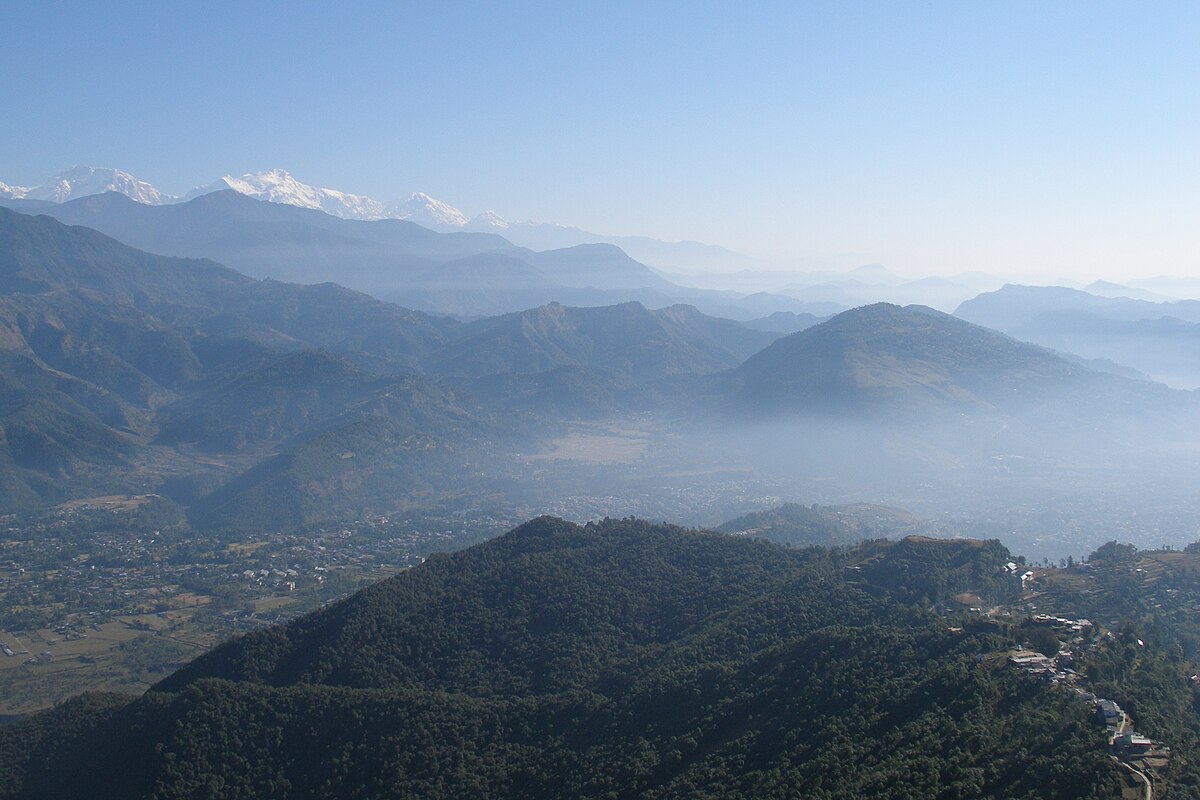
Summers, though pleasant, bring in the rains that Pokhara sometimes is notorious for. And the sunburns, for people who aren’t accustomed to Pokhara-esque sunshine, are common if you like to stroll around the daytime, trying to take in the delight of a city.
Local customs and etiquette
Nepalese, especially in the western part of the country, are friendly and welcoming to tourists from within and outside the country. “Atithi Devo Bhawah” is a common phrase that people around here use. This loosely translates as “Guests are akin to Gods.” The word “Namaste,” which is used as a greeting, in the past meant “I bow down to the Divine in you,” though this connotation to this word has mellowed down.
People who don’t take off their shoes while visiting a temple are perceived as ones that are crossing the unspoken rule about the sanctity of religious places. Pointing your feet at someone (while crossing your legs) might be offensive to some, and so can a public display of affection for your loved one.
Pokhara is a relatively safe city. However, it is still a good idea to be on the cautious side. Avoid taking a solo stroll in areas with poor lighting, and use caution, especially if you are going out late at night. Avoid carrying large sums of cash or expensive jewelry, and always store your valuables in a secure location.
More useful advice
You can rent a vehicle or rickshaw to get around Pokhara. Apps such as “Pathao” or “InDriver” are useful tools to master to get some bearing on the price of cabs or bikes. You can also rent a bicycle, motorbike, or car for several days.
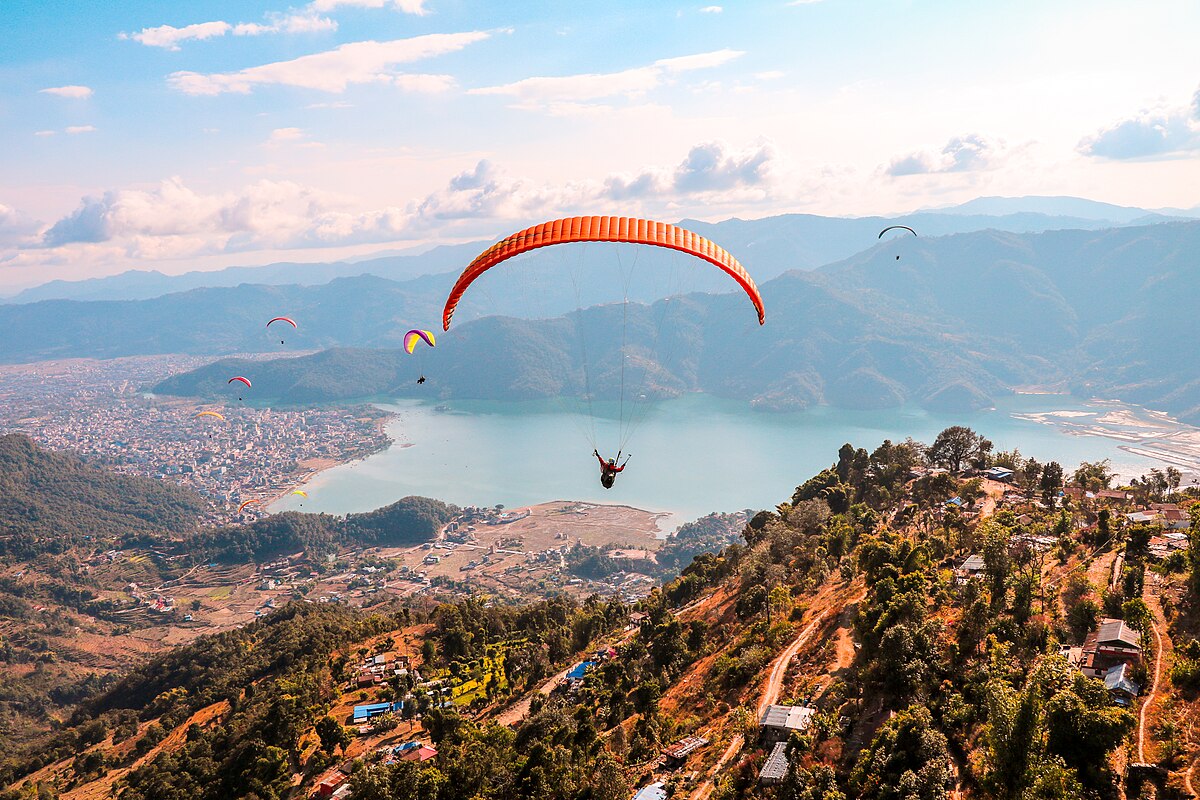
Photo: Nirmal Dulal | Wikimedia Commons
There are many ATMs in Pokhara. A lot of hotels have the convenience of using Phone Pay or an ATM card directly. But carrying cash in smaller denominations for street sellers and tiny shops is always a good idea.
Food and Drink in Pokhara
Like most places in Nepal, Pokhara serves a wide range of delectable food from across the world- from traditional Nepali food and Nepali alcohol to Continental food.
Local cuisine and specialties
A bustle of spices is what adds to the richness of Nepali food. In addition to being geographically gifted for being home to various species of rice, pulses, and vegetables, the addition of an equally large array of spices is what gives zing to Nepalese food.
Permutations and combinations of these spices, lentils, and vegetables give a different ring to traditional Nepali food wherever you go. In villages and restaurants serving traditional Nepalese food, topping Daal Bhaat with Ghee (clarified butter) adds to what is already a balanced diet. In Hindu scriptures such as the Vedas, it has been recommended to consume Ghee even if you have to borrow money to get it.
Note: Watch out for Ghee if you’re lactose intolerant!!
Momos (dumplings) are another food that is popular, not as dinner but as supper. The dumplings can be stuffed with vegetables, chicken, or buffalo meat. The dough which encases the stuffing is often refined flour which has its own health hazards. And some reports of unsavory parts of animals (such as buffalo and chicken) used for preparing the stuffing surfaces from time to time.
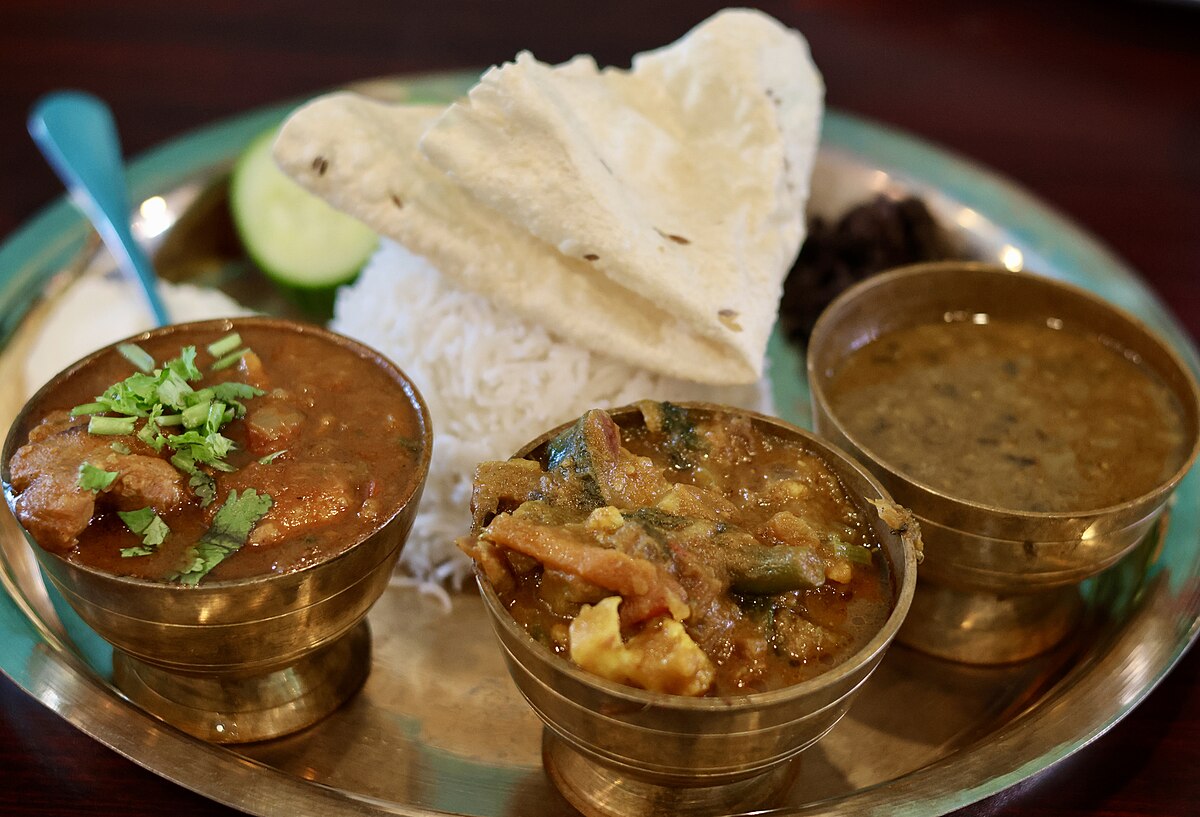
Photo: Trilok Neupane | Wikimedia Commons
But this doesn’t deter millions of Nepalese and foreigners from drooling over momo and the soup that goes with it.
Newari food such as Choila (grilled meat marinated in spices) and Sekuwa (barbecued meat) are amongst other more popular foods. Legend has it that the last king of Kaski asked 16 people of the Newar community to come to Pokhara and develop the present-day market. So much for the king’s effort to add a bit of zing to the diversity of food served in Pokhara!!
Drinks
Chhyang, Raksi, Jaad, and Tongba are some traditional Nepalese alcoholic beverages. These alcoholic drinks are brewed and distilled at homes of various communities such as Limbu and Kirat. In some factions of the Newar community, their traditional alcoholic beverage, Aila, is served during religious ceremonies. These drinks are often complemented with Choila and Sekuwaa.
These are being increasingly abandoned as Nepal is importing bottled beverages from outside the country and producing drinks such as wine, beer, vodka, whiskey, etc., in the country itself is on the rise. This has also created environmental problems as the proper dispensing of the bottles the beverages are sold in. This is an area that neither the government nor the enterprises that produce them have focused on.
For teetotalers, there are drinks such as “Lassi” (fruit and curd blended together with nuts and sweets) or Coca-Cola, Pepsi, and their variants. There are also local variants of “Red Bull” and fruit juice of various flavors, such as mongo, litchi, etc., that you can get in local fruit shops or in retail shops.
Shopping in Pokhara
The markets in Pokhara offer a wide selection of fabrics, clothing (from world-renowned brands), and regional clothing. Shopping here is fun, and there are lots of stores and markets to discover.
Local Textile
In terms of textiles, Pokhara offers a vast selection of materials like cotton, silk, and wool. Handwoven and hand-dyed fabrics are widely available and provide an interesting and genuine keepsake to bring back home. Many items, including scarves, bags, and clothes, are made from these textiles.
In the local marketplaces, you may buy traditional Nepali attire like saris, kurta pajamas, and dhotis. These clothing items frequently have handwoven materials and elaborate stitching and embellishments.
Gifts and handicrafts
In the local markets, you can discover homemade things like wooden statues, masks, and pottery- making Pokhara a great place for buying souvenirs. Also, there are stores that sell jewelry, precious stones, and other adornments that sometimes reflect the Tibetan way of life or Hinduism.
Local shops also have excellent notebooks made from Nepali paper (Lokta), handmade incense sticks, and soap.
Shopping Ethically
There are a few things to consider if you wish to shop ethically in Pokhara. Find stores that offer fair trade goods or that promote regional artisans and crafters. Buy things that don’t harm the environment or exploit animals. Also, exercise caution when haggling and make an effort to pay a reasonable amount for the products you buy.
To sum up, shopping in Pokhara is a delightful and enjoyable experience. The local markets offer a wide selection of fabrics, apparel, handicrafts, and souvenirs. You’re likely to find something that grabs your attention, whether you’re seeking traditional Nepali apparel or worldwide brands. Remember to shop morally and patronize neighborhood establishments whenever you can.
Things to Do in Pokhara
Some of the top activities in Pokhara- this touristic destination par-excellence include the following:
Trekking
The Annapurna Circuit and the Annapurna Base Camp trek are two of the most well-known trekking routes that begin and end in Pokhara. You can also take shorter hikes in the Pokhara area, such as the Poon Hill hike, that anyone can embark upon.
Paragliding
Beginning in the early 1990s, paragliding in Pokhara has grown to be one of the most exhilarating activities in the city. The busiest months for this adrenaline-pumping activity are September through November and February through May. The 30-minute paragliding ride provides breathtaking views of the Mountains, Phewa Lake, and the surrounding countryside.
Zip-lining
Another of the thrilling sports in Pokhara is zip-lining, which lets you soar above the Seti River while admiring the breathtaking vistas of the nearby mountains and valleys. After the construction of the city’s first zip line in 2012, the activity has gained popularity as an adventure sport in Pokhara.
The zip-line travels from Sarangkot, a mountaintop at 1,592 meters above sea level, to Hemja, a settlement on the other side of the river, where it comes to an end. The zip-line ride lasts around 90 seconds, and the full trip takes about 2 hours. Depending on the firm and the package you select, the cost of the trip can range from NPR 5000 to NPR 7000.
Mountain biking
Pokhara City has several routes that cover various terrains and skill requirements, from leisurely rides through the countryside to heart-pounding downhill descents. Depending on the tour operator and the package you select, the cost of the trip might range from NPR 3000 to NPR 5000 each day.
The duration of the journey also varies based on the terrain and your pace, although most excursions take between 1-3 days. The Dhampus Loop, the Upper Mustang region, and the Annapurna Circuit are a few well-known paths.
Yoga and Meditation
Numerous yoga and meditation centers in Pokhara can accommodate people of all skill levels and interests. Yoga and meditation can help lessen stress, anxiety, and depression while also enhancing one’s physical and mental health.
Several yoga studios offer multi-day retreats incorporating yoga, meditation, and healing modalities like massage and Ayurveda. These retreats range in price from NPR 15,000 to NPR 50,000 but can cost more or less based on the length, style of lodging, and services offered.
There are also centers where you can train as a Yoga teacher.
Spa and wellness
Spas and wellness centers in Pokhara provide a wide range of treatments and therapies, such as a yoga retreat, herbal steam room, or traditional Nepalese massage. Coupling this at the end of a biking/ hiking excursion might suit you best as it might help you soak in the experiences you gained during the trip.
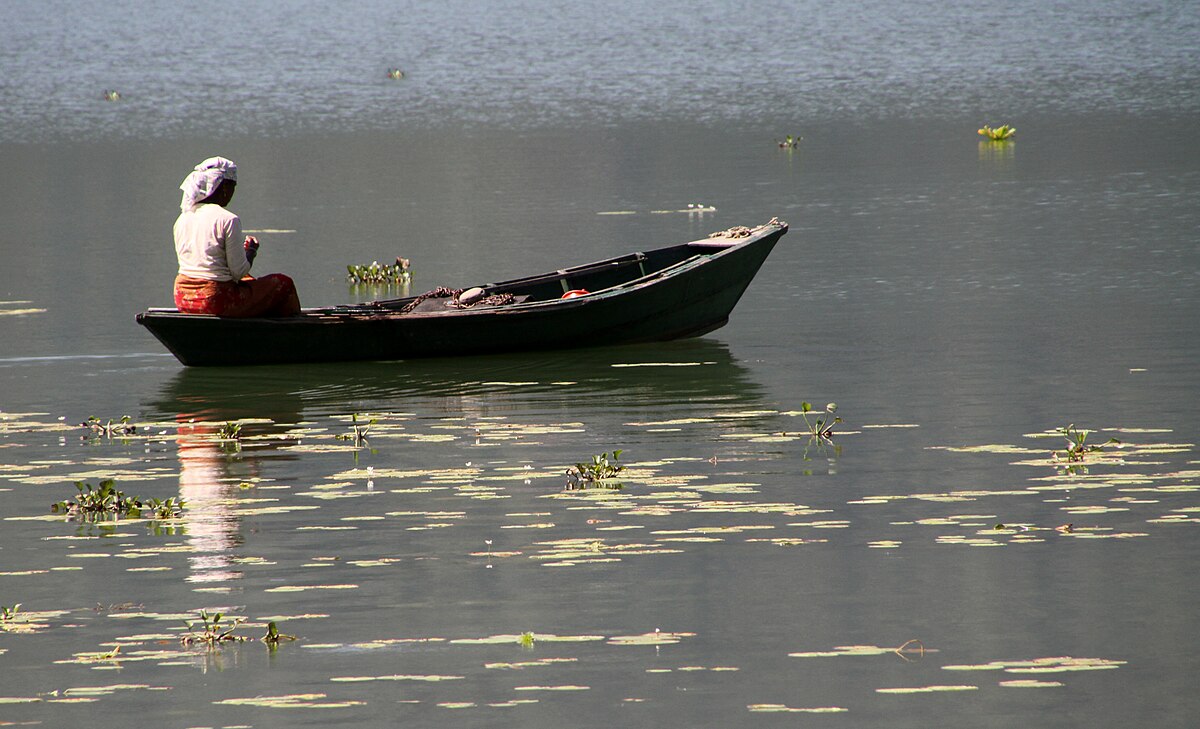
Boating
Phewa Lake in Pokhara is known for its tranquil boating excursions, especially as the evening draws near. You can hire a row or paddleboat to explore the calm waterways while taking in views of the hills and mountains nearby. Boating is also the only means of getting to Taal Barahi Temple.
Environmental Impacts of Tourism in Pokhara
If you talk to a lot of locals in Pokhara, they’ll tell you that the mountains in Pokhara aren’t as snowy-white as they used to be. They believe that the barrenness of its surrounding mountains is only increasing every year, a sentiment shared by many. This might not be a local problem, but something that has ties to global warming on a massive scale.
There are other environmental problems in Pokhara. Here are a few of them:
Shrinking of Fewa Lake
According to a scientific study, Fewa Lake accumulates more than 142,000 tonnes of sediment each year. Based on the study of the shrinkage of the area of the lake and sediment influx, a scientific report reported that this glorious lake might:
“Lose up to 80% of its storage capacity in the next 110–347 years, which will affect recreational use, agricultural irrigation, fishing, and a one-megawatt hydroelectric power facility.”
The report went on to say that in order to curb this problem, it is a must:
“Address the landslide activity and sediment transport in the watershed, as well as urban expansion along the shores.”
Threat to the Water-Ecosystem
A growing number of restaurants around Phewa Lake has deleterious effects on the population of the fish found here. Talking to Aviation Nepal News, a local businessman said, “The demand for fish from Fewa Lake in restaurants is enormous. This unconscionable rise is something the lake can’t put up with”.
He further went on to say, “Restaurants might say that they serve fish from this lake, but that’s only a hox. Many restaurants around here serve fish from India. The size of the fishes found here has considerably shrunk in the past few decades.”
With prestigious institutions such as Manipal Teaching Hospital directly dumping their waste in the Seti River, many locals have followed suit.
Other Problems
Pokhara is the place that receives the highest amount of rain in Nepal. Torrential rain in the monsoon adds to the woes of sediment deposition from landslides.
Transitioning into a full-fledged city has swelled the air pollution in Pokhara. Public Apathy is another of the reasons why Pokhara is touted to become “the next Kathmandu” if it doesn’t put in a lot of effort to deal with the growing environmental impact.
Some Things about Tourism in Pokhara that are Hidden from Plain Sight
In Pokhara, there are several instances of encouraging eco-friendly behaviors and eco-friendly tourism practices:
Eco-Trekking
Several hiking companies in Pokhara have implemented eco-trekking procedures to reduce their environmental impact. Examples of these behaviors include:
- Using eco-friendly camping supplies.
- Cutting back on plastic use.
- Leaving no trace.
Community-Based Tourism
This up-and-coming trend in Pokhara encourages visitors to stay with local families and learn about their way of life. By generating cash for neighborhood populations and minimizing the detrimental effects of tourism, this initiative encourages sustainable tourism practices.
Hotels with solar energy
Several Pokhara hotels have turned to solar energy to lessen their carbon footprint. To generate electricity, some hotels have solar panels installed to do away with their reliance on fossil fuels.
Green Transport
Electric buses and rentable bicycles are examples of Pokhara’s recent green transportation projects. These programs encourage environmentally friendly modes of transportation and lessen the damaging effects of vehicle pollution.
Conclusion
Pokhara is an ever-green travel destination. And it has been so for more than a few decades. With exhilarating sports such as bungee-jumping, paragliding, and mountain biking, if you get bored in Pokhara, you’re the one to blame. If you’re someone who likes enjoying low-key things, i.e., through yoga, tranquil treks, or simply spa-ing, Pokhara has it all.
But there have been a few problems related to land and water pollution that tourism has brought about. And these might not have easy solutions, though the government is trying to curb these changes. All we ask of you is to travel responsibly.
